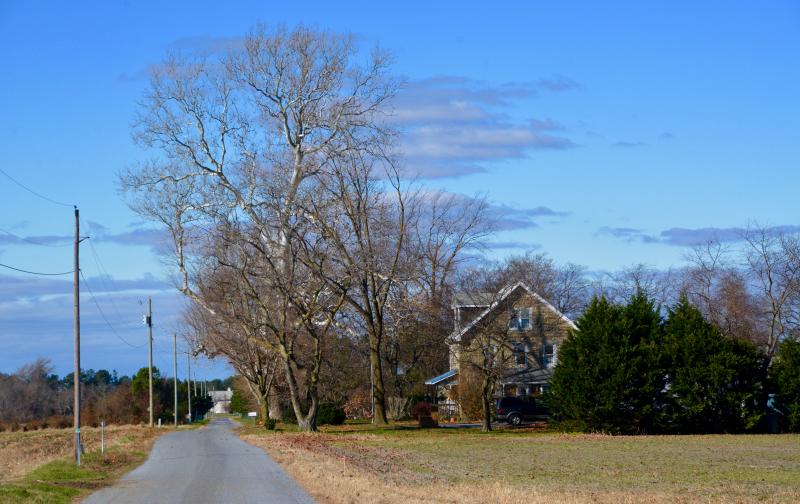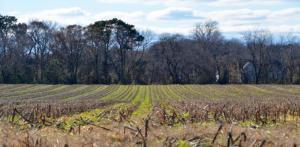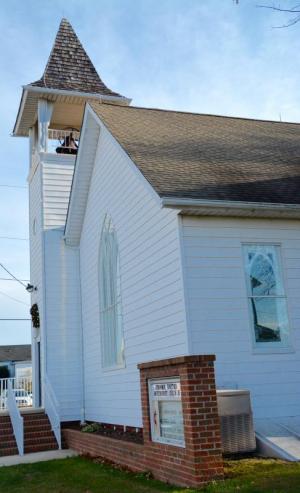The record remains open on a subdivision application for a tract near Lewes that has caused debate for more than four years.
Developer New Road Ventures LLC has filed an application for Tower Hill, a 292 single-family-home subdivision on 134 acres along New Road near Lewes owned by Groome United Methodist Church.
During the more than three-hour hearing Nov. 29 before Sussex County Planning and Zoning Commission, the standing-room-only crowd heard testimony about the history of the parcel dating back to Native American settlements and later farming of the land in the 17th century by the Prettyman family.
They heard from local Native Americans about the cultural importance of the parcel, prompting an apology from a Prettyman descendant for family's actions toward indigenous people. They also heard about efforts to preserve the property that fell short.
Opponents said the commission should delay a vote until more information from state agencies could be garnered, including updated traffic data and a review of the project by Delaware Department of Natural Resources and Environmental Control staff.
The commission voted to leave the public record open to receive the developer's traffic impact study and the Delaware Department of Transportation response to the study. Once the data is received, the record will be left open for seven days for written public comment. The application is on the commission's Thursday, Dec. 13 agenda.
Native American concerns
Descendent Ralph Prettyman said when his colonial ancestors were in the area, there was already a great nation of Native Americans, including the Sikanese Tribe. “So I apologize on behalf of our colonial ancestors,” he said. “We did some things to the indigenous people, but today we all live here together. It's up to all of us to respect their rights and wishes and to honor their history. I want to make it clear that is part of our intention.”
He said he would work with local Native Americans on the text for one of two historical markers and no development will take place on sites where indigenous artifacts were discovered. During an archeological survey of the parcel artifacts were located, but no human remains, outside of the Prettyman cemetery, were found, according to Jim Fuqua, the developer's attorney.
“What you call artifacts, we call living pieces of our people,” said Ragatha Rain Calentine of the Saligna Tribe. “We have to honor them in a good way; they belong to the people. That is very important to us.”
She said Native Americans performed ceremonies before the archeological survey of the parcel. She said the artifacts should be given to the Nanticokes.
“You talked about having the Prettyman family with a graveyard, but you also know our people were there. I did not hear that we could come and visit our relatives. How will that happen? How will you let people know we lived here for more than 6,000 years and then our land was taken?” she asked. “You have an opportunity to do the right thing to honor the people however your heart desires.”
Nanticoke Tribe Chief Natasha Norwood Carmine said seven generations of Native Americans walked the lands near Canary Creek. She offered several conditions:
• The Nanticokes and Lenapes, the state's two recognized tribes, should be involved in writing verbiage on the historical marker.
• The public should have access to the marker. “I think that could possibly be worked out,” Commission Chairman Bob Wheatley said.
• The Nanticoke Museum in Long Neck should be the repository of any Native American artifacts. “The applicant is nodding his head in agreement,” Wheatley noted.
• The archeological survey should be made available to the Nanticoke and Lenape tribes as well as the public, which will occur.
Long history of property
No other piece of property in recent memory has more history – and drawn more attention – than the Groome property.
John Prettyman purchased 200 acres in 1696 and called his farm Tower Hill; he eventually would own 475 acres. The land stayed in the family for 230 years until it was sold to Ira Brittingham in 1926. John Prettyman, a 10th generation relative, wrote a 130-page book about the history of the property.
After Ira and his son, Chester, passed away, Groome U.M. Church received the property in the early 1970s in accordance with a Brittingham will. Officials at the church made it known they had plans to sell the land and use the proceeds to build a new church, expand programs and establish an endowment.
In an effort to preserve the land from development, Fuqua said, in 2014 a group formed made up of state, county, city and Lewes residents to raise funds to purchase the property. “They were asking for a fair-market price but the funds the group came up with were significantly less than the asking price,” Fuqua said.
After three years, he said, in July 2017 the church inked an agreement with New Road Ventures to sell the land, but left the door open for 15 days for the preservation group to match the offer.
“Funding for preservation was not available. It's a shame because that was a desirable goal. It was a disappointment,” he said.
Fuqua said the sale created unfortunate bitterness toward the church. “The church was not responsible for the preservation effort outcome,” he said. “The reason it failed was funding. The bottom line is that the church made a wise investment in the 1970s and is prepared to expand with a new church.”
Archeological survey completed
Fuqua said the developer voluntarily paid $450,000 for an archeological survey of the parcel even though Delaware law does not require one.
During phase one in December 2017, dirt was dug up in the wooded sections and the field was surveyed after it was plowed. Archeologist Edward Otter also researched the history of the property.
During the second and third phases of the investigation this past summer, archeologists dug 163, 5-foot-by-5-foot pits by hand removing 200 tons of soil.
Fuqua said the Prettyman family cemetery was located and delineated on the west side of the parcel.
Fuqua said while artifacts were removed, the goal of the survey was to locate archeological sites and not gather artifacts. “All potential sites will be left undisturbed by the developer,” he said. He said five sites, located on the northeast corner and western side of the property, will be marked on the site plan as off limits to development.
He said it's not determined whether the artifacts will be given to the state or the Lewes Historical Society. It's possible some will be turned over to the Nanticoke Indian Museum.
Otter said some 6,000 artifacts, including lots of broken brick and glass from the 1770-1840 home site, were recovered. He said part of the Prettyman farm foundation and chimney were found. Native American artifacts, including pottery pieces and arrowheads, were also recovered.
Otter said he has 500 bags of soil yet to analyze and the final report will take about a year to complete. Once it's complete, the report will be made public.
Fuqua said the developer has a long list of conditions regarding the Prettyman cemetery, including cleanup of the site, four brick corner markers and two granite benches, perpetual access to family and friends and the erection of historical markers depicting the Native American history and Colonial and post-Colonial history of the site.
Opposition to the application
Debra Evalts, representing the New Road Preservation Alliance, led the presentation with a power point outlining the organization's opposition to the application. She said area residents are concerned that overdevelopment and increased density along New Road will lead to more flooding in an area where flooding is already a problem. “A new Canary Creek bridge is needed before 292 new homes are built,” she said.
“Neighbors are scared,” she said. “It's an onslaught firing at us all at once. We feel overwhelmed and worried about our area.” She said the proposed density of two units per acre is not compatible with other housing in the area. “It's too dense. It does conform to code but you have to look at the broader area. It's not the density of neighboring areas,” she said.
She said with planned Route 1-Minos Conaway road improvements, more motorists will use New Road for access to Lewes, and the commission does not have the most updated traffic data. “This is a big request. You need to wait. There is no hurry when you are talking about development on a parcel this precious,” she said.
Alliance member Doug Spelman said of all the issues involving the application, DNREC's lack of comments during the preliminary land-use service process is problematic. “I'm sure you will approve this, but you have the right to expect help from state agencies. It's a shame, and you deserve better,” he said.
Spelman suggested a third-party credentialed archeological expert be on hand to examine excavations during the initial stages of the project. He said the site plan should be reworked to protect forested areas. He said under the current plan, almost 70 percent of trees would be removed.
Ron Vickers, who lives on New Road, said it's important to keep all wooded areas connected to the wetlands to maintain a more ecological balance on the property.
Rob Morgan, a Lewes councilman, said the record should remain open to consider the results of a hydrological study on the Canary Creek basin coordinated by Lewes officials as well as a DelDOT analysis of all projects underway in the New Road area.
Lewes resident and retired land planner Melanie Mosser said the subdivision only meets minimum cluster requirements. “What is innovative about this subdivision?” she asked.
She, and others, testified the subdivision was not compatible with the density of other communities along New Road.
Wheatley said compatibility is not a legal standard in Sussex County. “We have 17 other standards. Perhaps this should be one. You need to take that up with county council,” he said.
Developer: $3 million in roadwork
Lynn Road – Two, 11-foot travel lanes with 5-foot shoulders, 30-foot right of way on both sides and a 15-foot easement on both sides for a paved, shared-use path.
New Road – Two 15-foot travel lanes with 6-foot shoulders, 40-foot right of way on north side with 15-foot easement for paved, shared-use path.
Lynn Road-New Road intersection – Reconstructed to a single-lane roundabout.
Off site – Extension of widening of New Road with two 11-foot travel lanes with 6-foot shoulders to Schaeffer Lane and Ashburn Lane.
A preliminary landscape plan in coordination with the Historic Lewes Scenic Byway committee has been drawn out. A master plan for the road, one of three entrance roads designated as a byway, is being developed.
Gail VanGilder, byway chairwoman, said the proposed plan screens all stormwater ponds and homes from view of the road. When the landscape plan is finalized, it will be noted on the site plan. “It's agreed we will continue to work on the plan as engineering takes place,” she said.
Fuqua said the final plan for landscaping will be consistent with goals of the byway master plan. The 85- to 125-foot buffer will be maintained by the community's homeowners association.
The developer will also contribute funding to the pending Old Orchard-Wescoats Road realignment or the Canary Creek bridge elevation project as determined by state transportation officials.
Details of proposed plan
Fuqua said the average lot size would be 8,600 square feet. Gutters, sidewalks and curbing would be on both sides of all of the tree-lined streets. He said 60 acres – or 45 percent – of the parcel would remain as open space. Lewes Board of Public Works would provide water and sewer with infrastructure costs covered by the developer.
Plans include a 3-acre recreation area with a pool, decking, clubhouse and gazebo and pickle ball and bocce courts. Six smaller pocket parks are also planned.
The plans include a minimum 50-foot buffer from the Townsend farm property to the north and a 20-foot landscaped buffer on other sides of the parcel. He said 8 acres of nontidal wetlands and sites ranging from 4 acres to less than 3,000 square feet of state tidal wetlands will be delineated and undisturbed.
Fuqua said special concessions are being made to protect the Dawson property – where a family resides – located in the middle of the parcel on Lynn Road, including a sewer lateral for future hookup.
He said there would be a 20-foot buffer on three sides of the property surrounded by open space. A large sycamore tree along Lynn Road would be preserved.
Fuqua said the subdivision is a permitted use under AR-1 zoning and in an environmentally sensitive developing overlay zone. “The applicant has made sure all concerns and impacts have been properly addressed,” Fuqua said.

























































